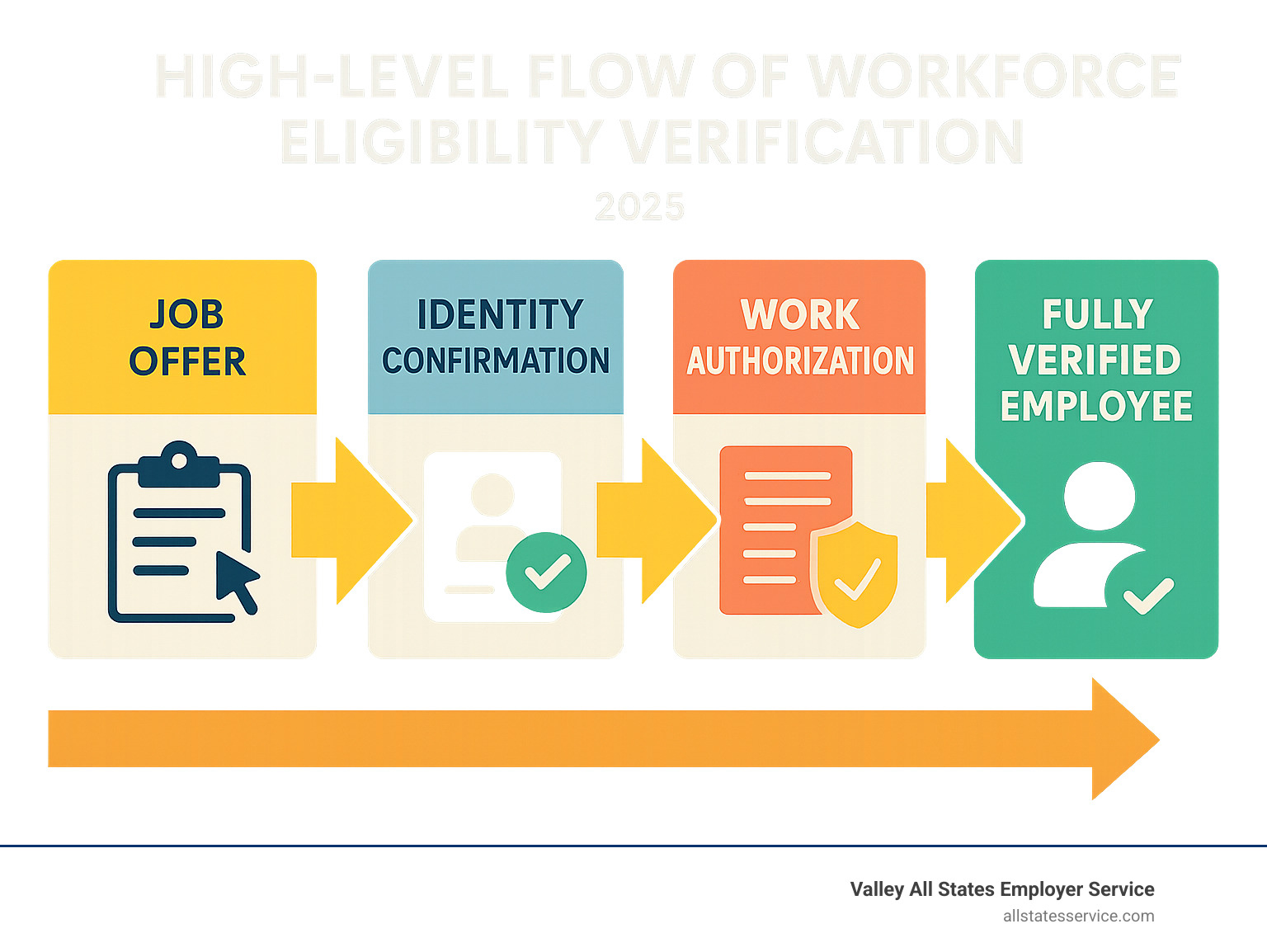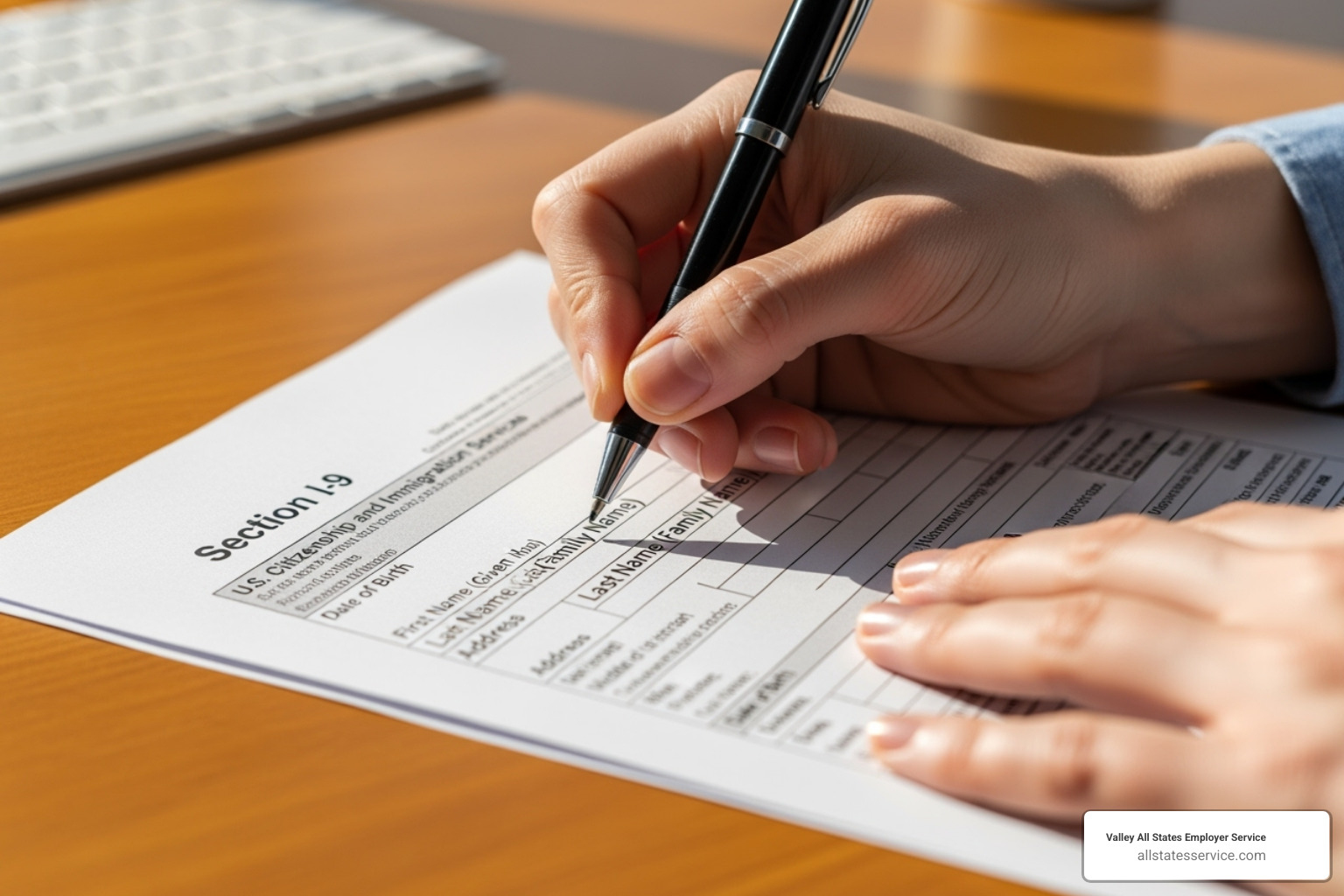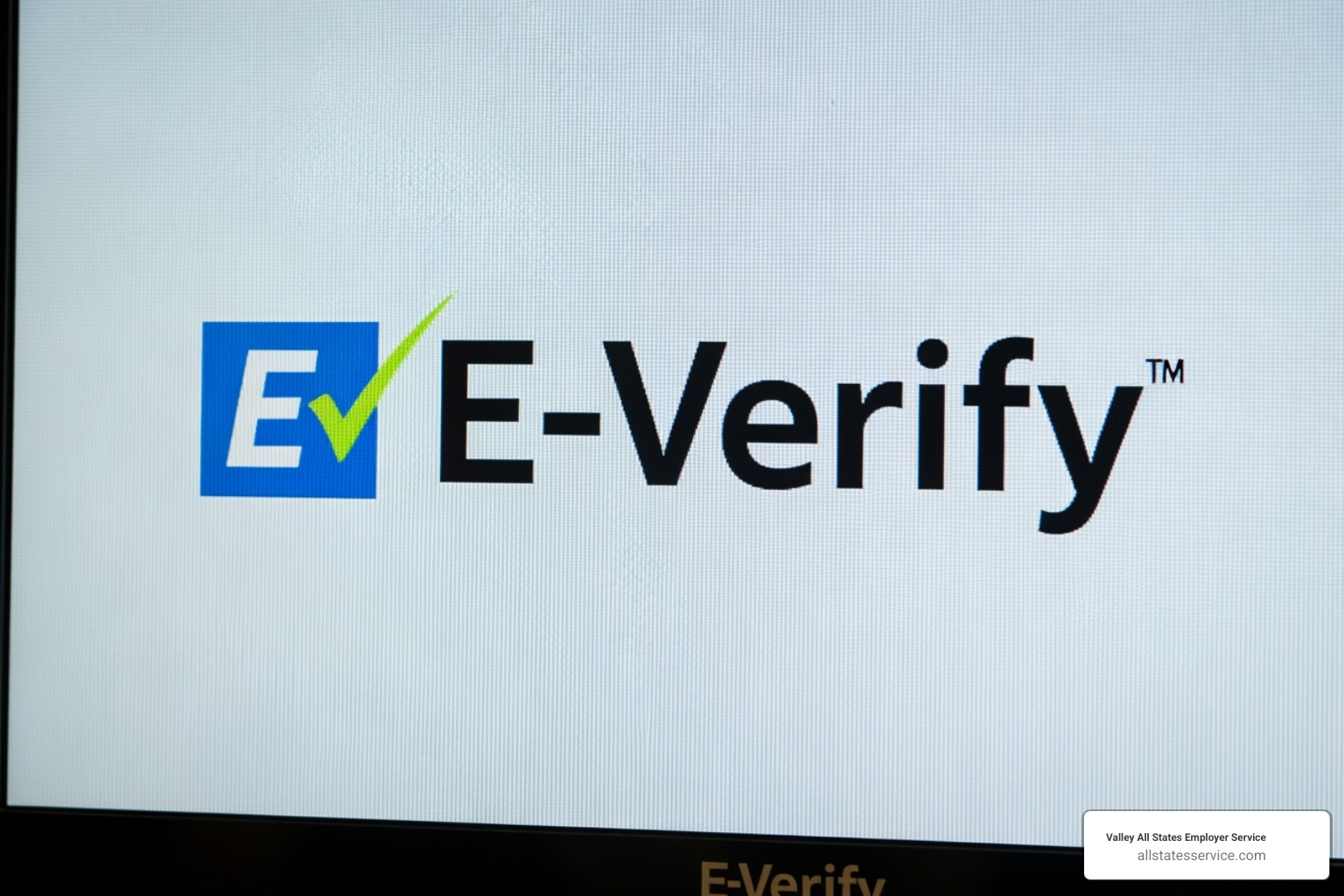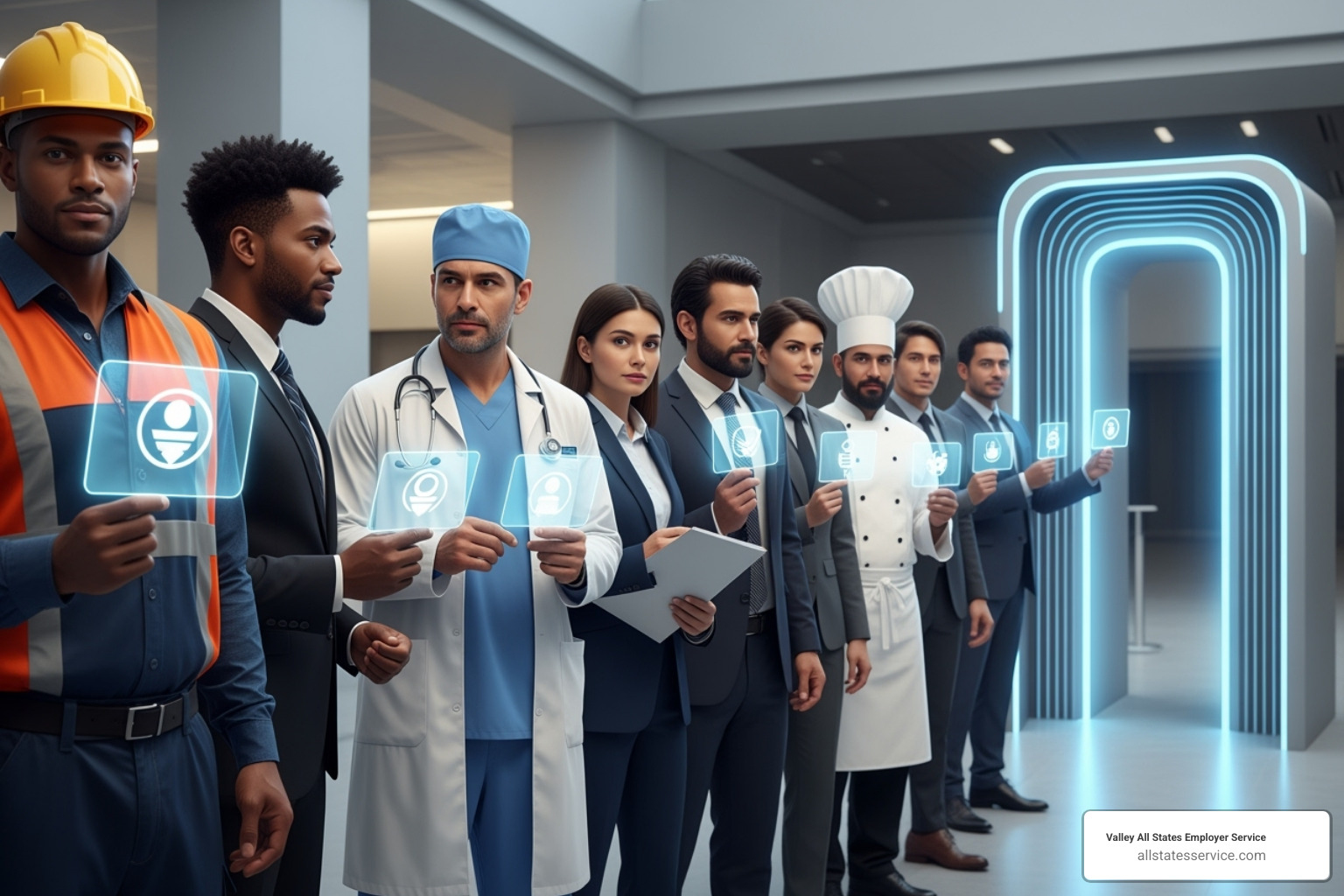The First Step to a Compliant Team
Workforce eligibility verification is how employers confirm an employee’s legal right to work in the United States. This process is crucial for every business. It ensures you build a legal and compliant team.
Here’s a quick look at what it involves:
- Identity Confirmation: Making sure the person is who they say they are.
- Work Authorization: Checking if they are legally allowed to work in the U.S.
- Federal Compliance: Following rules set by laws like the Immigration Reform and Control Act (IRCA).
- Key Tools: Using official forms like Form I-9 and systems like E-Verify.
For HR managers, navigating these rules can feel like a maze. It involves detailed steps and strict timelines. You want to avoid penalties and streamline your hiring.
This guide will help you understand every part of workforce eligibility verification. We will simplify the complex regulations. Our goal is to give you clarity and confidence in your hiring process.

The Foundation: Mastering Form I-9, Employment Eligibility Verification
So, you’ve found the perfect new team member, congratulations! But before they can officially join your ranks, there’s a crucial step every U.S. employer must take: workforce eligibility verification. This is where the mighty Form I-9, Employment Eligibility Verification, steps onto the stage. It’s not just a piece of paper, it’s the very foundation of building a compliant and legally authorized team.
Think of Form I-9 as your go-to tool for peace of mind. It helps you confirm if your new hire is a U.S. citizen, a lawful permanent resident, or someone otherwise authorized to work here. Both the employee and you, as the employer, have a part to play in filling it out correctly. This ensures everything is accurate and accountable. Plus, you’ll need to hold onto these forms for specific periods, ready to show them if government officials from the Department of Homeland Security (DHS), Department of Labor (DOL), or Department of Justice (DOJ) come knocking for an inspection.
For all the official details and instructions, the USCIS website is your best friend.
Completing Form I-9: A Step-by-Step Guide
Getting Form I-9 right is super important, but don’t worry, we’ll walk you through it. It’s broken down into a couple of key sections.

Section 1: Employee Information and Attestation
This first part is all about the employee. They need to fill out Section 1 on or before their very first day of work for pay. Here, they’ll share their personal details like name, address, date of birth, and Social Security Number. The most important part? They’ll swear, under penalty of perjury, that their work status is legit. They’ll tell you if they’re a U.S. citizen, a noncitizen national, a lawful permanent resident, or an alien authorized to work. If they’re the latter, they’ll also add their Alien Registration Number, USCIS Number, or Form I-94 Admission Number.
Section 2: Employer Review and Verification
Now it’s your turn! As the employer, you need to complete Section 2 within three business days of the employee’s first paid workday. This involves taking a good look at their original documents. These documents prove two things: their identity and their legal right to work. Employees get to choose from a “List of Acceptable Documents.” They can either show you:
- One document from List A, which proves both identity and work authorization. Think of things like a U.S. Passport, a Permanent Resident Card, or an Employment Authorization Document (EAD).
- Or, they can show you one document from List B (which just proves identity, like a driver’s license or state ID card) and one document from List C (which proves work authorization, such as an unrestricted Social Security card or a birth certificate).
Once you’ve seen the documents, you’ll record their details—like the title, who issued it, the number, and when it expires—right there in Section 2. You’re also attesting that the documents look real and belong to the person showing them to you.
For the full rundown on what documents are acceptable, check out the official Lists of Acceptable Documents. And hey, if this all feels a bit overwhelming, remember our team is here to offer expert I-9 Verification Assistance!
The Modern Shift: Remote Document Examination
Remember the good old days (or maybe not so good) when remote work meant scrambling to figure out I-9s? The traditional in-person document check became a real headache for our increasingly distributed teams. Well, good news! The Department of Homeland Security (DHS) heard our pleas and introduced a permanent, alternative way to remotely examine Form I-9 documents. This is a game-changer for how employers handle workforce eligibility verification!
This fantastic new procedure isn’t for everyone, though. It’s specifically for employers who are enrolled in E-Verify and have a good standing with the system. If that’s you, then you can now remotely review your employee’s I-9 documents. How does it work? Typically, it involves a live video call where your employee holds up their documents for you to see. Just remember to keep clear copies of those documents! This flexibility is a huge win for businesses with remote or hybrid workforces.
A quick heads-up: if you’re not an E-Verify employer, the old rules still apply—you’ll need to physically examine those I-9 documents. Also, keep an eye out for the new Form I-9 (dated “08/01/23”). It now has a handy checkbox to show you used the remote procedure, and it became mandatory on November 1, 2023.
Want to dive deeper into this update? Head over to the official E-Verify website. And, of course, our team is always here to help with your Employee Onboarding Compliance, making sure you steer these modern requirements with ease.
Record Keeping, Reverification, and Audits
Think of your Form I-9s like precious treasures – proper record keeping is just as vital as filling them out correctly! You need to hold onto each completed Form I-9 for a specific amount of time. Here’s the golden rule: keep the form for either three years after the date you hired the employee or one year after their employment ends, whichever date comes later. So, if an employee works for you for two years, you’d keep their I-9 for three years from their hire date. If they stick around for five years, you’d hold onto it for one year after they leave.
Reverification: Keeping Up with Eligibility
For some employees, especially those with temporary work authorization, you might need to re-check their employment eligibility. This is called reverification, and you’ll do it on Supplement B (Page 4) of Form I-9, which used to be known as Section 3. The key is to do this before their current work authorization expires. Just a note: you won’t need to reverify U.S. citizens or lawful permanent residents.
What about rehires? If you bring back an employee within three years of when you first completed their Form I-9, you might be able to simply reuse their old form, updating it with any new information needed. Easy peasy!
Storing I-9s Securely
These forms contain sensitive personal details, so keeping them safe and sound is a must. While you don’t send them to USCIS or ICE, they absolutely must be ready for inspection by authorized government officials if they ask to see them.
Preparing for Audits: Stay Ahead of the Game
Nobody loves an audit, but Immigration and Customs Enforcement (ICE) does conduct them to make sure businesses are compliant. Being prepared means having all your Forms I-9 perfectly completed, signed, and neatly stored. A smart move is to conduct an internal I-9 Self-Audit. This helps you spot and fix any little errors before an official audit comes knocking, giving you extra peace of mind.
Leveling Up Compliance: Understanding the E-Verify System
While Form I-9 is absolutely essential, E-Verify takes your workforce eligibility verification to a whole new level. Think of it as the advanced tool that works hand-in-hand with your I-9s. It is a powerful online system designed to make confirming employment eligibility faster and even more reliable.

So, what exactly is E-Verify? It is a web-based system run by U.S. Citizenship and Immigration Services (USCIS), which is part of the Department of Homeland Security (DHS). They work with the Social Security Administration (SSA) to make it happen. When you use E-Verify, you are comparing the information from your new employee’s Form I-9 against official records. This helps confirm their legal right to work in the United States.
It is considered the best way to electronically confirm if someone is authorized to work. Plus, it is available across all U.S. states and several territories. You can always visit the official site at E-Verify: Home for more details. And if you need a hand with the process, our team offers comprehensive E-Verify Background Checks.
Who Needs to Use E-Verify? Mandatory vs. Voluntary
You might be wondering, “Do I have to use E-Verify?” For most employers, participation is actually voluntary. This means businesses have the choice to use the system or not. However, there are some important situations where E-Verify becomes a must-do:
- Federal Contractors: If your business holds federal contracts or subcontracts that include the Federal Acquisition Regulation (FAR) E-Verify clause, then using E-Verify is a requirement. It is part of doing business with the federal government.
- State-Level Mandates: Many states have passed their own laws that make E-Verify mandatory for certain employers. For instance, some states require it for all employers, while others focus on public agencies, government contractors, or private businesses once they reach a certain number of employees. You will find mandatory E-Verify laws in states like Arizona, Mississippi, Georgia, Utah, Nebraska, Missouri, Rhode Island, Colorado, North Carolina, Idaho, and Minnesota.
- Legal Rulings: In some special cases, a legal ruling might require an employer to participate in E-Verify.
It is super important to know your specific obligations, as state laws can be quite different. To make sure you are meeting all the necessary requirements, take a look at our resources on E-Verify Employer Requirements.
The E-Verify Process: A Key Step in Workforce Eligibility Verification
Using E-Verify might sound complicated, but it is actually a pretty straightforward process once you are set up. Let us walk through how it works:
- Enrollment: First things first, your business needs to enroll in the E-Verify system. This is your gateway to confirming legal employment.
- Form I-9 Completion: Just like we talked about, your new hire completes Section 1 of their Form I-9. Then, you complete Section 2. This happens after they accept a job offer.
- Case Creation: Now, here is where E-Verify comes in. No later than the third business day after your employee starts working for pay, you need to create a case in E-Verify. You will enter the information from their completed Form I-9 right into the system.
- Database Check: E-Verify takes this information and quickly compares it against records from the Social Security Administration (SSA) and the Department of Homeland Security (DHS).
- The Result: Most of the time, cases come back as “Employment Authorized” within seconds. This means your employee’s information matches government records, and they are good to go!
- Tentative Nonconfirmation (TNC): Sometimes, there is a mismatch. This is called a Tentative Nonconfirmation, or TNC. It does not mean your employee cannot work. It just means there is something that needs to be clarified. Maybe a name change has not been updated with the SSA, or there was a simple data entry error. If a TNC happens, you must inform your employee and give them a chance to resolve it with the SSA or DHS within a set timeframe.
The E-Verify submission process can be incredibly quick. For example, some E-Verify Employer Agents can complete this entire process in less than 24 hours. If you use E-Verify, you also need to display “Right to Work” and “E-Verify Participation” notices where everyone can see them.
Want a quick visual? You can Watch this quick video to learn about E-Verify. And for hands-on assistance with the process, our team offers specialized E-Verify Services.
Benefits of Using E-Verify for Your Business
Beyond simply meeting compliance rules, choosing to use E-Verify brings some fantastic advantages for your business. It truly helps take your company to the next level.
- Increased Accuracy and Reduced Fraud: E-Verify checks employment eligibility electronically. This helps you avoid issues like social security mismatches or even falsified documents. The result? A more accurate and trustworthy team.
- Good Faith Compliance Defense: Using E-Verify shows that you are making a genuine effort to follow federal law. This can be a strong defense if your business ever faces an audit or investigation.
- Peace of Mind: Imagine knowing for sure that every one of your employees is legally authorized to work in the U.S. That brings incredible peace of mind! It helps build trusting relationships from the very start of the hiring process.
- Access to Remote I-9 Verification: Remember how we talked about remote I-9 verification? Being enrolled in E-Verify is the key to using that alternative procedure for examining documents remotely. This is a huge flexibility for today’s businesses.
- Improved Workforce Integrity: By consistently verifying who is eligible to work, you are contributing to a legal and ethical workforce. This can seriously boost your company’s reputation and overall operational integrity.
It is clear why nearly 1 million employers, across more than 2.4 million hiring sites, currently use E-Verify. That is a lot of businesses seeing the benefits! By implementing E-Verify Best Practices, you can make these advantages work even harder for you.
Special Considerations for a Diverse Workforce
Our modern workplaces are vibrant tapestries of talent, bringing together folks from all walks of life. This includes our amazing U.S. citizens, of course, but also lawful permanent residents (you might know them as green card holders!), nonimmigrant visa holders like those on H-1B or L-1 visas, and even refugees and asylees who have found protection here.

While the core workforce eligibility verification process remains largely the same for everyone, there are some specific, important considerations when you’re bringing on non-U.S. citizens. Their authorization to work is often tied to their immigration status.
For a deeper dive into temporary workers and their authorization, the USCIS Temporary Workers page is an excellent resource.
Verifying Employees with Temporary Work Authorization
Think of it this way: for many non-U.S. citizens, their permission to work often comes with a “valid until” date. This is typically found on their Employment Authorization Document (EAD), sometimes called Form I-766.
Sometimes, these EADs get an automatic extension. It’s like a temporary grace period, often announced by USCIS. We’ve seen this happen for specific groups, like certain Hong Kong residents or Venezuelan TPS beneficiaries. While these extensions are a huge help, they can also make things a bit more complex. You’ll need to understand the specific dates and category codes (like A11 for DED or A12/C19 for TPS) to ensure you’re completing Form I-9 correctly and planning for reverification.
You’ll need to reverify these employees before their extended work authorization expires. For instance, if those Hong Kong DED beneficiaries had an extension through February 5, 2027, you’d need to reverify them by February 6, 2027. This ever-changing landscape of temporary work authorization really highlights why staying up-to-date with USCIS announcements is so important. Our team can help you steer these nuances with our Employment And Income Verification Services.
Handling Unique Situations and Updates
Life happens, right? And sometimes, that means dealing with situations that aren’t quite “by the book” when it comes to workforce eligibility verification. Employers need to be ready for these unique scenarios and stay on top of the latest guidance.
If an employee has a name change, for example, it’s super important they update their information with the Social Security Administration (SSA) and DHS. This helps avoid hiccups later, especially with E-Verify. What if documents are lost or stolen? Don’t panic! USCIS has guidance on how employees can still prove their eligibility, often by presenting a receipt for a replacement application.
And then there are emergencies and unforeseen circumstances – think natural disasters. USCIS often steps in with special guidance during these times, offering flexibility or alternative procedures. For instance, specific instructions were provided for those affected by hurricanes, which can be found in the Guidance for Those Affected by Emergencies.
Even specific groups like Afghan and Ukrainian parolees have unique verification pathways that USCIS regularly updates. For example, some Afghan parolees can use their I-94 as a temporary List A receipt. However, they’ll need to present a permanent document, like an EAD, within 90 days. Staying current on USCIS alerts and official announcements is absolutely vital for smooth operations. This kind of vigilance is a key part of effective Pre-Employment Work History Verification.
Staying Compliant and Avoiding Penalties in Workforce Eligibility Verification
Navigating workforce eligibility verification can feel like walking a tightrope. It is incredibly important to get it right, because falling short of compliance can bring serious repercussions for employers. The government takes these requirements very seriously, and the penalties can range from significant financial hits to even criminal charges.
Imagine facing substantial monetary fines for each and every mistake on a Form I-9, or for inadvertently hiring someone who isn’t authorized to work. These fines can quickly pile up, especially for larger businesses. In more severe cases, particularly if there’s a pattern of knowingly hiring or continuing to employ unauthorized workers, employers or key individuals within the company might even face criminal penalties, including potential imprisonment.
For federal contractors, the stakes are even higher. Non-compliance could lead to debarment from government contracts, meaning your business could be barred from receiving future federal work. On top of that, Immigration and Customs Enforcement (ICE) conducts regular audits. If they find violations, it can result in formal Notices of Intent to Fine (NIFs) and, in some instances, trigger criminal investigations.
It is also crucial to remember the anti-discrimination provisions. You cannot ask for more or different documents than what’s required, nor can you refuse valid documents, or retaliate against employees asserting their rights. These actions can also lead to hefty penalties. Building robust Employer HR Compliance isn’t just about avoiding trouble; it is about establishing a legal and ethical foundation for your entire business.
Common I-9 and E-Verify Mistakes to Avoid
Even with the best intentions, it is easy to stumble when it comes to workforce eligibility verification. We often see employers making similar, preventable errors. Being aware of these pitfalls is the first step to avoiding them.
One of the most frequent mistakes is late completion. Section 1 of Form I-9 must be completed by the employee on or before their first day of work for pay, and Section 2 must be completed by the employer within three business days. Another common issue is missing information, like blank fields, forgotten signatures, or omitted dates. These small oversights can lead to big problems during an audit.
Then there is over-documentation. It might seem like being thorough, but asking for specific documents, or more documents than legally required, can actually be seen as a form of discrimination. Similarly, accepting expired documents or failing to check expiration dates is a clear violation. And do not forget failing to reverify employees whose temporary work authorization has an expiration date.
Lastly, be mindful of treating employee groups differently. Applying varied verification standards based on someone’s nationality, citizenship, or perceived immigration status is a serious error and can lead to discrimination claims. Staying diligent and properly training your team are key to minimizing these errors. If you ever find yourself needing a helping hand, our E-Verify Customer Support team is always ready to assist.
The Case for Outsourcing Your Workforce Eligibility Verification
Given how complex and high-stakes workforce eligibility verification can be, many employers are finding the incredible value of outsourcing their I-9 and E-Verify processes. Partnering with expert third-party agents offers a multitude of compelling benefits.
Think about the time your HR team spends managing these intricate forms and processes. Outsourcing can drastically reduce administrative burden, freeing up your valuable internal staff to focus on critical core HR functions like nurturing talent and boosting employee engagement. This is not just about offloading tasks; it is about strategically optimizing your resources.
Furthermore, expert third-party agents specialize in these exact processes. They are always up-to-date on the latest regulations, forms, and procedures, which significantly improves accuracy and minimizes errors. For instance, our team at Valley All States Employer Service prides itself on processing E-Verify submissions quickly, often completing the verification in less than 24 hours. We offer expert, impartial, and efficient E-Verify processing, ensuring you have confidence in your workforce eligibility verification.
You also gain access to invaluable expert guidance. These agents can steer complex scenarios like the new remote document examination procedures or specific work authorization categories. They can even review I-9s for technical errors or provide electronic I-9s with smart-form technology, making the process smoother and more reliable.
The convenience and flexibility are undeniable. Services like “I-9 Anywhere” offer vast networks of authorized representatives, with over 2,000 convenient locations for in-person Section 2 completion, alongside virtual options. This flexibility is a game-changer for businesses with remote or distributed workforces.
Partnering with a trusted provider means gaining immense peace of mind. You know your workforce eligibility verification is being handled correctly, minimizing errors and administrative burden. This strategic partnership provides robust Outsourced Compliance Solutions that allow you to focus on growing your business, not on compliance headaches. Explore our E-Verify Employer Agent Service to see how we can help.
Conclusion: Achieve Confidence in Your Hiring Compliance
We’ve journeyed through the ins and outs of workforce eligibility verification, haven’t we? From mastering the essential Form I-9 to leveraging the powerful E-Verify system, it’s clear how crucial these steps are for building a strong, legal, and confident team. You’ve learned about key timelines, modern solutions like remote document checks, and even how to handle the unique situations of a diverse workforce.
Keeping up with all the rules and regulations can feel like a full-time job in itself. The penalties for getting it wrong are just too serious to ignore. But here’s the good news: understanding common pitfalls and knowing when to seek expert help can transform a tough compliance task into a smooth, efficient operation.
That’s exactly where Valley All States Employer Service comes in. We’re here to take the complexity out of workforce eligibility verification for you. Our team brings the precision and expertise you need, ensuring your processes are handled correctly and efficiently. This means you can breathe easy and focus on what you do best: growing your business.
Ready to achieve that peace of mind and streamline your hiring process? Find how simple compliance can be with our Automated Eligibility Verification System today.